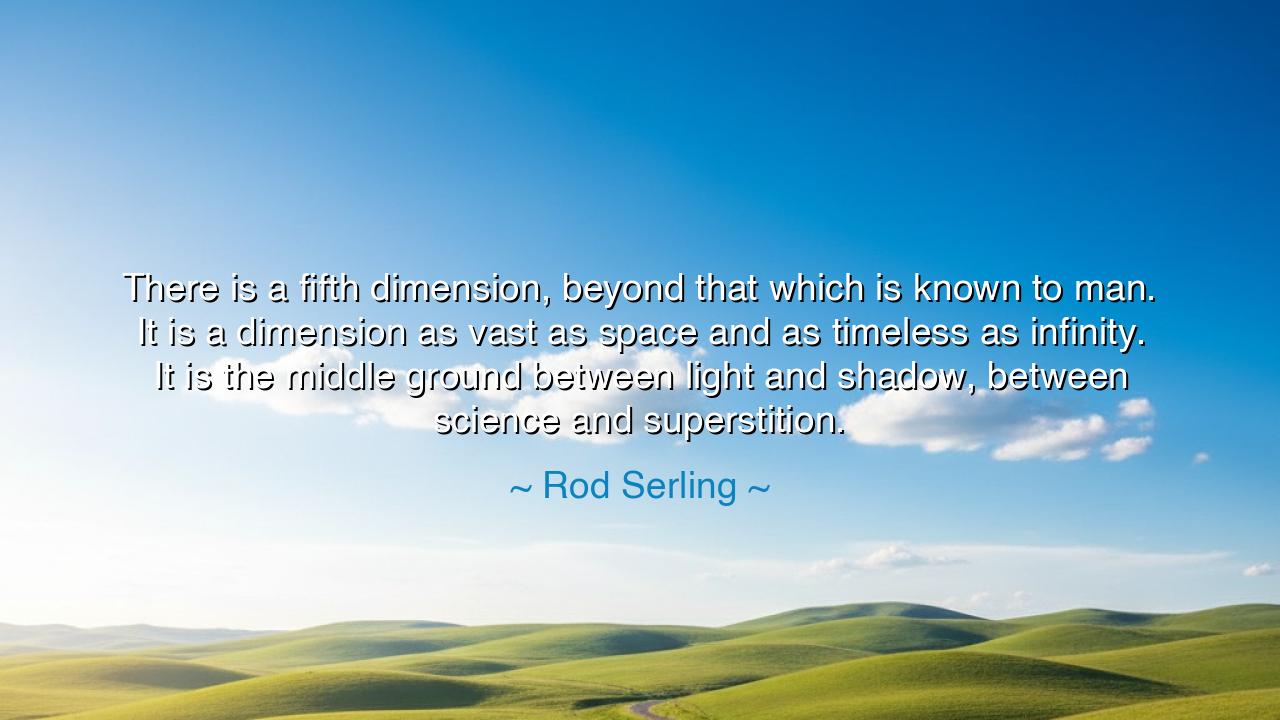
There is a fifth dimension, beyond that which is known to man. It
There is a fifth dimension, beyond that which is known to man. It is a dimension as vast as space and as timeless as infinity. It is the middle ground between light and shadow, between science and superstition.






"There is a fifth dimension, beyond that which is known to man. It is a dimension as vast as space and as timeless as infinity. It is the middle ground between light and shadow, between science and superstition." These words, spoken by Rod Serling, beckon us to consider the boundaries of human understanding—the limits of what we know and what we do not know, that space where the mystical and the scientific intersect. Serling’s vision of the fifth dimension is a profound reminder that there exists a realm beyond our comprehension, where the very nature of reality becomes fluid, shifting between the known and the unknown, between what is rational and what is mysterious.
In ancient times, the wise men of the East and West grappled with similar mysteries. The great Greek philosophers such as Plato and Aristotle pondered the nature of existence, seeking to understand the universe and its workings. Yet, even in their vast wisdom, they acknowledged that there were realms of understanding that lay beyond the grasp of human intellect. Plato, in his famous Allegory of the Cave, spoke of the limitations of human perception. The prisoners in the cave, chained and forced to stare at shadows, could not understand the truth of reality beyond their chains. Serling’s fifth dimension, much like Plato’s cave, is a metaphor for the spaces we cannot see, the truths we cannot perceive, yet which may hold the key to unlocking the full nature of existence.
Consider the story of Galileo Galilei, who, with his telescope, uncovered truths about the universe that were previously hidden. Through his work, Galileo revealed a cosmos far grander and more complex than any had imagined, shattering the understanding of the world that had been held by the Church for centuries. Yet, even as his discoveries pushed the boundaries of scientific knowledge, Galileo remained humble in his understanding, acknowledging that what he had uncovered was but a small piece of the infinite expanse of the universe. His journey represents the eternal struggle of humanity to understand the realms beyond our immediate sight, to venture into the fifth dimension where knowledge and mystery coexist.
Serling's quote also evokes the balance between light and shadow, science and superstition. In every era, the mystical has been juxtaposed with the rational. Science, with its pursuit of objective truth, is often seen as the beacon of light in the darkness of ignorance. But in every age, there have been those who sought the truth through superstition, through unseen forces and beliefs that seem irrational but hold a kind of mystical power over the human heart. In the Middle Ages, for example, the belief in alchemy was widespread, as people sought to transform base metals into gold, to uncover the secrets of life through the mystical arts. While alchemy may seem like an ancient superstition today, it laid the groundwork for the scientific method and modern chemistry.
Serling’s vision of the fifth dimension challenges us to think beyond the confines of rigid categories, to see that the boundaries between reason and faith, light and darkness, are not always so clear-cut. Like the journey of Isaac Newton, whose discovery of the laws of motion and gravity revealed the hidden forces of nature, yet who also spent much of his life exploring theological and mystical subjects, we too must embrace the idea that knowledge is not always confined to the realms of the measurable and the observable. The mystical and the scientific may, in fact, be two sides of the same coin, each offering insights into the deeper truths of existence.
In our own time, we must learn to walk the middle ground that Serling speaks of—recognizing that science is not the only path to understanding, nor is the mystical realm of belief the sole avenue to insight. The fifth dimension, as Serling presents it, is a call for us to open our minds to the unseen and unexplored, to be willing to venture beyond the boundaries of conventional thinking and embrace the mysteries that remain hidden. It is a challenge to seek wisdom in places where light and shadow intertwine, where reason and imagination meet.
Thus, the lesson here is one of curiosity and humility. In seeking truth, we must not close ourselves off to the mysteries that exist beyond the visible and the known. Whether through the lens of science, the wisdom of philosophy, or the spiritual insights of the mystics, we must remain open to the infinite possibilities that lie in the fifth dimension. Just as Galileo looked beyond the stars, and Newton sought truth in both the physical and spiritual worlds, so must we embrace the challenge of seeing the world through a broader lens—one that includes both the rational and the mystical, the known and the unknown.
Let us therefore strive to explore the mysteries that lie beyond our immediate understanding. Let us ask questions without fear of their answers, venture into realms unknown, and recognize that truth is often hidden in places where light and shadow converge. Like the great explorers of both science and spirit, we must embark on our own journeys into the fifth dimension, knowing that it is not the destination that matters most, but the willingness to seek, to question, and to discover what lies hidden in the vast, timeless expanse of infinity.






AAdministratorAdministrator
Welcome, honored guests. Please leave a comment, we will respond soon